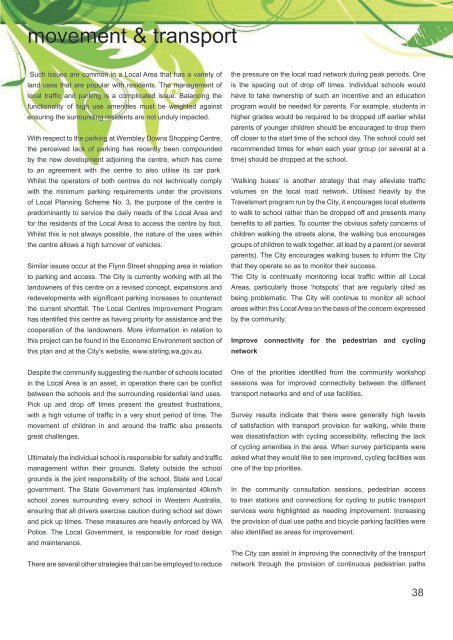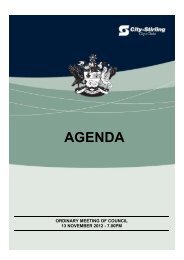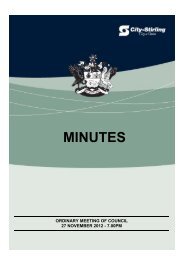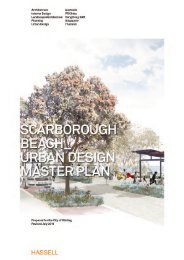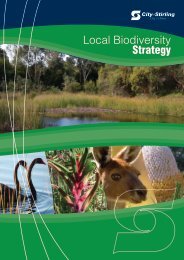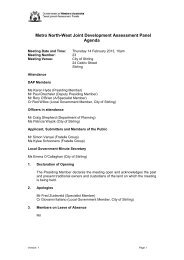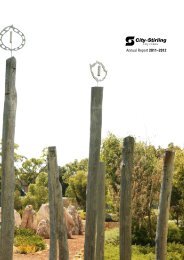Wembley Local Area Plan - City of Stirling
Wembley Local Area Plan - City of Stirling
Wembley Local Area Plan - City of Stirling
You also want an ePaper? Increase the reach of your titles
YUMPU automatically turns print PDFs into web optimized ePapers that Google loves.
movement & transport<br />
movement & transport<br />
Such issues are common in a <strong>Local</strong> <strong>Area</strong> that has a variety <strong>of</strong><br />
land uses that are popular with residents. The management <strong>of</strong><br />
local traffic and parking is a complicated issue. Balancing the<br />
functionality <strong>of</strong> high use amenities must be weighted against<br />
ensuring the surrounding residents are not unduly impacted.<br />
With respect to the parking at <strong>Wembley</strong> Downs Shopping Centre,<br />
the perceived lack <strong>of</strong> parking has recently been compounded<br />
by the new development adjoining the centre, which has come<br />
to an agreement with the centre to also utilise its car park.<br />
Whilst the operators <strong>of</strong> both centres do not technically comply<br />
with the minimum parking requirements under the provisions<br />
<strong>of</strong> <strong>Local</strong> <strong>Plan</strong>ning Scheme No. 3, the purpose <strong>of</strong> the centre is<br />
predominantly to service the daily needs <strong>of</strong> the <strong>Local</strong> <strong>Area</strong> and<br />
for the residents <strong>of</strong> the <strong>Local</strong> <strong>Area</strong> to access the centre by foot.<br />
Whilst this is not always possible, the nature <strong>of</strong> the uses within<br />
the centre allows a high turnover <strong>of</strong> vehicles.<br />
Similar issues occur at the Flynn Street shopping area in relation<br />
to parking and access. The <strong>City</strong> is currently working with all the<br />
landowners <strong>of</strong> this centre on a revised concept, expansions and<br />
redevelopments with significant parking increases to counteract<br />
the current shortfall. The <strong>Local</strong> Centres Improvement Program<br />
has identified this centre as having priority for assistance and the<br />
cooperation <strong>of</strong> the landowners. More information in relation to<br />
this project can be found in the Economic Environment section <strong>of</strong><br />
this plan and at the <strong>City</strong>’s website, www.stirling,wa,gov.au.<br />
Despite the community suggesting the number <strong>of</strong> schools located<br />
in the <strong>Local</strong> <strong>Area</strong> is an asset, in operation there can be conflict<br />
between the schools and the surrounding residential land uses.<br />
Pick up and drop <strong>of</strong>f times present the greatest frustrations,<br />
with a high volume <strong>of</strong> traffic in a very short period <strong>of</strong> time. The<br />
movement <strong>of</strong> children in and around the traffic also presents<br />
great challenges.<br />
Ultimately the individual school is responsible for safety and traffic<br />
management within their grounds. Safety outside the school<br />
grounds is the joint responsibility <strong>of</strong> the school, State and <strong>Local</strong><br />
government. The State Government has implemented 40km/h<br />
school zones surrounding every school in Western Australia,<br />
ensuring that all drivers exercise caution during school set down<br />
and pick up times. These measures are heavily enforced by WA<br />
Police. The <strong>Local</strong> Government, is responsible for road design<br />
and maintenance.<br />
There are several other strategies that can be employed to reduce<br />
the pressure on the local road network during peak periods. One<br />
is the spacing out <strong>of</strong> drop <strong>of</strong>f times. Individual schools would<br />
have to take ownership <strong>of</strong> such an incentive and an education<br />
program would be needed for parents. For example, students in<br />
higher grades would be required to be dropped <strong>of</strong>f earlier whilst<br />
parents <strong>of</strong> younger children should be encouraged to drop them<br />
<strong>of</strong>f closer to the start time <strong>of</strong> the school day. The school could set<br />
recommended times for when each year group (or several at a<br />
time) should be dropped at the school.<br />
‘Walking buses’ is another strategy that may alleviate traffic<br />
volumes on the local road network. Utilised heavily by the<br />
Travelsmart program run by the <strong>City</strong>, it encourages local students<br />
to walk to school rather than be dropped <strong>of</strong>f and presents many<br />
benefits to all parties. To counter the obvious safety concerns <strong>of</strong><br />
children walking the streets alone, the walking bus encourages<br />
groups <strong>of</strong> children to walk together, all lead by a parent (or several<br />
parents). The <strong>City</strong> encourages walking buses to inform the <strong>City</strong><br />
that they operate so as to monitor their success.<br />
The <strong>City</strong> is continually monitoring local traffic within all <strong>Local</strong><br />
<strong>Area</strong>s, particularly those ‘hotspots’ that are regularly cited as<br />
being problematic. The <strong>City</strong> will continue to monitor all school<br />
areas within this <strong>Local</strong> <strong>Area</strong> on the basis <strong>of</strong> the concern expressed<br />
by the community.<br />
Improve connectivity for the pedestrian and cycling<br />
network<br />
One <strong>of</strong> the priorities identified from the community workshop<br />
sessions was for improved connectivity between the different<br />
transport networks and end <strong>of</strong> use facilities.<br />
Survey results indicate that there were generally high levels<br />
<strong>of</strong> satisfaction with transport provision for walking, while there<br />
was dissatisfaction with cycling accessibility, reflecting the lack<br />
<strong>of</strong> cycling amenities in the area. When survey participants were<br />
asked what they would like to see improved, cycling facilities was<br />
one <strong>of</strong> the top priorities.<br />
In the community consultation sessions, pedestrian access<br />
to train stations and connections for cycling to public transport<br />
services were highlighted as needing improvement. Increasing<br />
the provision <strong>of</strong> dual use paths and bicycle parking facilities were<br />
also identified as areas for improvement.<br />
The <strong>City</strong> can assist in improving the connectivity <strong>of</strong> the transport<br />
network through the provision <strong>of</strong> continuous pedestrian paths<br />
and cycleways in the <strong>Local</strong> <strong>Area</strong>. The <strong>City</strong> is in the process<br />
<strong>of</strong> finalising a Footpath Policy and Bikeplan to oversee the<br />
management <strong>of</strong> footpath and cycling infrastructure and address<br />
gaps in the <strong>City</strong>’s pedestrian and cycling network.<br />
<strong>Wembley</strong> Downs Shopping Centre<br />
Outcomes to Achieve<br />
1. To continue to implement the principles <strong>of</strong> the <strong>City</strong>’s<br />
Integrated Transport Strategy.<br />
2. The <strong>City</strong>’s Travelsmart <strong>of</strong>ficer to continue to provide<br />
advice and programs promoting and encouraging<br />
sustainable transport use within the <strong>Local</strong> <strong>Area</strong>.<br />
3. Continue to liaise with the Public Transport Authority,<br />
providing input and advocating for community needs.<br />
4. To encourage patronage <strong>of</strong> public transport in and<br />
around local centres by promoting redevelopment<br />
and investigating the increase <strong>of</strong> density immediately<br />
surrounding the centres where appropriate.<br />
5. Continue to develop a pedestrian and cycle path network<br />
to ensure key linkages between existing sections <strong>of</strong> the<br />
current network and to major destinations.<br />
6. To work together with the State Government on any<br />
investigations or research required for the future use or<br />
development <strong>of</strong> the Stephenson Reservation.<br />
7. To continue negotiations with the Public Transport<br />
Authority through WALGA to resolve the issue regarding<br />
the ongoing provision and maintenance <strong>of</strong> bus shelters.<br />
8. To work in partnership with local schools in developing<br />
strategies for reducing the impact <strong>of</strong> traffic at school set<br />
down and pick up points during peak hour.<br />
38 39


